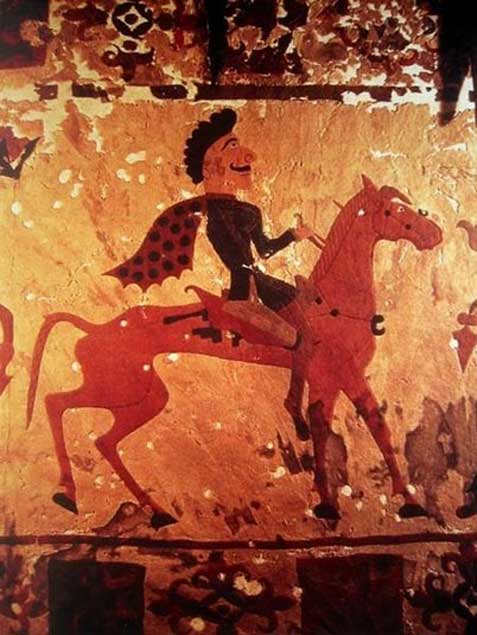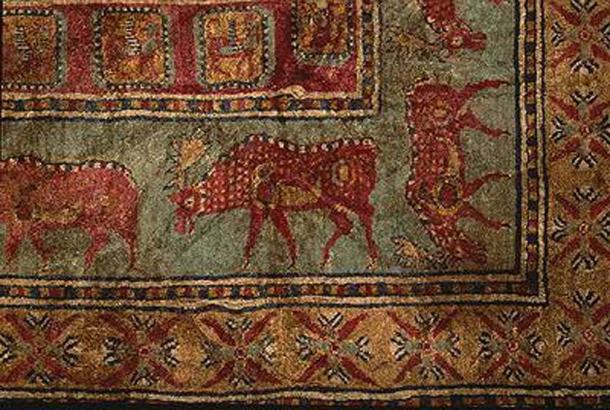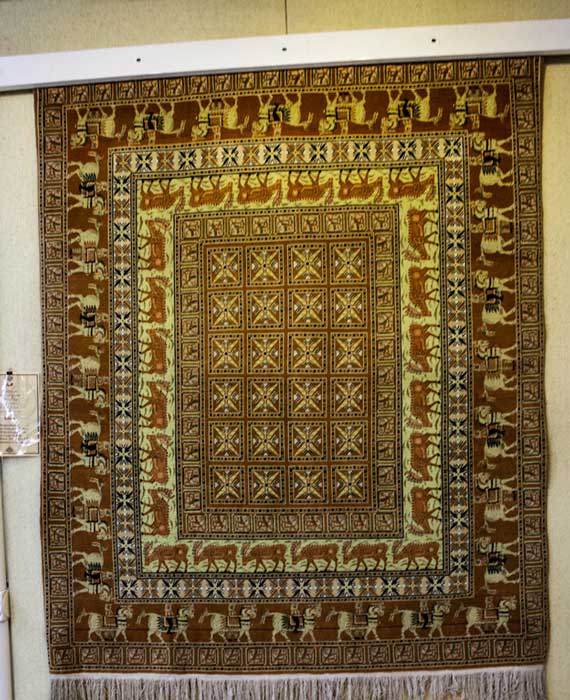2,500-Year-Old Carpet is a Stunning Reflection of Advanced Culture of the Pazyryk Nomads

2,500-Year-Old Carpet is a Stunning Reflection of Advanced Culture of the Pazyryk Nomads
The Pazyryk Carpet is the oldest known example of a carpet in existence today. Discovered in a state of almost perfect preservation, it was pulled from a royal tomb in the Pazyryk Valley of Siberia, Russia, and has been dated to around the 5 th century BC.

The Pazyryk tribe lived in the Altai Mountains in Siberia, south of the modern city of Novosibirsk, Russia. They were horse-riding nomads and warriors, who travelled by horseback to trade goods with merchants in China, India, and Persia.
Much of their culture has been revealed through findings of a series of tombs found in the Pazyryk Valley, including mummified human remains with detailed tattoos, golden treasures, felt hangings, Chinese silk, pile carpet, wooden furniture and household goods, which were preserved over the millennia due to water seeping into the tombs and freezing everything into solid blocks of ice. Human remains have revealed that the Pazyryk people were even carrying out advanced cranial surgery over 2,000 years ago.

The earliest carpets
It has been speculated that carpets were first produced in East Asia during the 2 nd millennium BC, though the domestication of sheep is said to have occurred several millennia earlier. As sheep’s wool is a natural fibre composed of animal proteins, specifically keratin, it is a source of food for microbes and insects. As a consequence, objects made of wool, including carpets, are highly susceptible to deterioration, and ancient specimens of wool are very rare, and may only be preserved under extremely fortuitous circumstances.
Carpets were used to adorn the court of Cyrus the Great, who founded the Achaemenid Empire around the middle of the 6th century B.C. Some have claimed, on the other hand, that carpet making was introduced by Cyrus into Persia a little later, i.e. after his conquest of Babylon in 539 BC. It has been speculated that the Persians could have been making woollen carpets even before the time of Cyrus, considering the fact that they possessed herds of sheep that would provide them with the raw materials needed to produce carpets.
Carpets of the Scythians
The oldest surviving example of a carpet, however, comes not from the lands that were once part of the Achaemenid Empire, but further to the area in its northeast, in the territory of the Scythians.
The Pazyryk Valley is known for its Scythian Iron Age tombs, and it was within one of these burial mounds that the Pazyryk Carpet was found. This precious archaeological object was discovered in 1949 by Sergei Rudenko, a Russian archaeologist.
Pot Luck Preserved Pazyryk Carpet
The Pazyryk Carpet has survived till today thanks to sheer luck. The burial mound where the carpet was found had been looted in the past. The grave robbers had taken all the precious contents within the burial, and the items considered to be of lesser value, such as the carpet, were left behind. The robbers had not bothered to cover the burial mound after they had looted it. As a result, water seeped in and covered the Pazyryk Carpet.
During the winter, the water froze, thus forming a protective layer over the carpet. It is due to this film of ice that the Pazyryk Carpet was preserved till the present day. The carpet is so well preserved that its colours, which were produced using dyes made of plants and insects, are still so vibrant even today.

Based on radiocarbon dating, archaeologists are able to say that the Pazyryk Carpet was made between the 5 th and 4 th centuries BC. Researchers have also been able say that the carpet was woven using a technique known as the “symmetrical double knot, the so-called Turkish knot”, and that the carpet contains over 1,250,000 knots. Unfortunately, researchers are not yet able to determine the origin of the Pazyryk Carpet.
One speculation is that the carpet was from Persia, whilst another suggests that it came from Central Asia, in the area where the Scythian and Persian cultures came into contact. Yet another possibility is that the Scythians themselves created this carpet, based on some Persian prototype.

As for the design of the Pazyryk Carpet, its central field is occupied by 24 squares, within each is a cross-shaped figure composed of four stylised lotus buds. This field is enclosed by a frame of griffins, followed by another fallow deer. In the outermost frame are men on horseback, as well as dismounted warriors.
The makers of the Pazyryk Carpet paid a lot of attention to the details of the figures. For instance, each fallow deer is depicted with its internal organs, including its heart, intestines, and maw. You can learn more about the interpretation of its features in the video below.
The Pazyryk Carpet is currently on display in the State Hermitage Museum in St. Petersburg, Russia, where much care has been given to ensure its preservation for future generations.